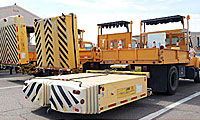All about attenuators
All about attenuators

Attenuators are important features that help keep drivers and ADOT crews safe.
They’re also something we’ve blogged about before, but since it’s been a couple of years, we thought we’d revisit the topic for our newer readers…
First, let’s talk about the types of attenuators you likely see every day during your commute.
These fixed attenuators are placed at the end of barrier walls on the freeway. You’ll see them near off-ramps or medians and anywhere a barrier wall comes to an end.
They are designed to take the impact of a vehicle collision and absorb a lot of the energy from a crash.
As we said back in 2011, this is by no means a physics blog, but a basic grasp of how energy works is needed to understand attenuators.
A vehicle’s speed and size determine how much energy it has. Normally, this energy is dissipated by your brakes, which burn off that energy slowly, allowing you to come to a safe stop.
But, if a vehicle stops by crashing into a wall, the energy is dispersed very suddenly, resulting in a car that’s crushed. Attenuators won't exactly give a soft landing, but they do work to dissipate the energy slowly like your brakes do. Various attenuators do this by different methods.
Next up, is the truck-mounted attenuator. You might have seen these, too, during your commute.
They’re the big rectangle-shaped “boxes” attached to the back of certain ADOT trucks. Inside that attenuator “box” is just a honeycomb configuration of aluminum, Styrofoam and air space.
They're simple, but they save lives and act as a kind of shield that stands between freeway traffic and ADOT crews. If a motorist travels into a freeway work site they’ll hit the attenuator instead of a heavy truck, or ADOT workers.
The truck-mounted attenuator, like the fixed attenuator, is designed to take the impact and crumples together as it absorbs the energy of the vehicle.
Now, let’s look at ADOT’s use of sand barrel crash cushions.
Like their name implies, sand barrel crash cushions are filled with sand, shaped like a barrel and work to provide a “cushion” if a vehicle were to crash into one.
A sand barrel crash cushion works similarly to the way an attenuator functions.
You’ve probably seen them several times on the side of the road. They’re placed strategically in front of fixed objects (signs, poles, etc.) and will take the impact if a driver runs into them.
They can be set up in different configurations depending on speed limits and the specifics of the location.
One common setup consists of 12 barrels (although, there are numerous variations). You’ll often see four of the barrels lined up single file. Behind those first four, there typically will be four more rows with barrels lined up two by two.
The weight of each barrel varies – they weigh 200, 400, 700 or 1,400 lbs. The lightest barrels are placed in front and they get progressively heavier to handle the impact, absorb and dissipate the energy of a crash.
